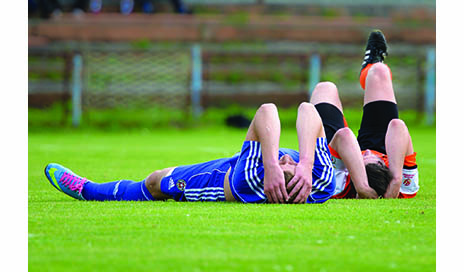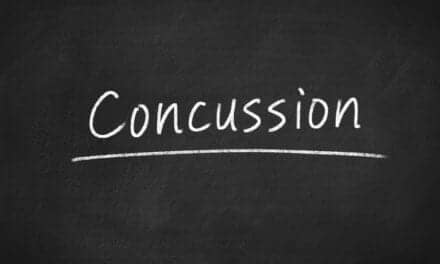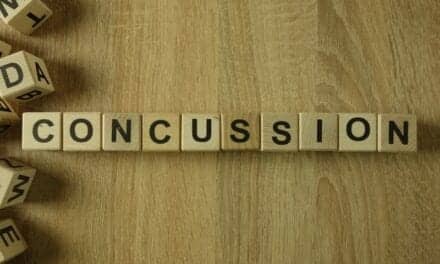By Bryan S. Hill, PT, FAFS, CAFS
The American Association of Neurological Surgeons estimates that more than 250,000 head injuries in the US are incurred while playing football at all levels, and that 10% of college players and 20% of high school players sustain brain injuries in any given season. Approximately 35 million children, ages 5 to 18, participate in organized sports each year (135,000 receiving brain injury treatment), with football and girl’s soccer having the highest rate of injury in the high school setting. With numbers of that magnitude, it seems now more than ever parents, coaches, and even players are becoming more knowledgeable with how serious a concussion is and are giving it more attention.
A concussion is a disturbance in brain function caused by a direct or indirect force to the head. It results in a variety of non-specific signs and symptoms. Concussion should be suspected in the presence of any one or more of the following:
• Symptoms (headache)
• Physical signs (unsteadiness)
• Impaired brain function (confusion)
• Abnormal behavior (change in personality)
In the event of a head injury, these steps should be followed:
• An assessment should be performed as soon as possible with the symptom graded checklist;
• If concussion is diagnosed or suspected, the athlete is removed from play immediately;
• Referral to a concussion specialist;
• Obtain an acute concussion evaluation (ACE) care plan; and
• Follow a return to sport plan.
Since the popular film Concussion was released in 2015, the topic has been highly publicized. The film’s real-life main character, Bennet Omalu, MD, gives a name to repeated head trauma: chronic traumatic encephalopathy (CTE). Riding in the film’s wake, California and many other states are instituting concussion management laws, which suggests the public has taken notice of this dangerous injury.
So what are physical therapist doing about it? Likewise, what steps should be taken when a head injury occurs? One model that has been effective has been developed by Rehab United, San Diego. The clinic contracts with five local high schools and provides athletic trainers to cover high school athletics. A professional soccer team is also covered in addition to several local teams and eight soccer tournaments. The practice sees many concussions. To deal effectively with this type of injury, a comprehensive concussion management program has been implemented at Rehab United. The program follows a diagnosis, symptom management, and return to play/school protocol.
Diagnosis
The first issue in concussion management is proper diagnosis. At the youth level, subjective reporting of young athletes can be unreliable at times. Full disclosure is often lacking. Therefore, many head injuries often go unreported and, thus, undiagnosed. Diagnosis and bringing awareness to the public is step one.
Many new systems for diagnosing concussions have been developed, several in the last few years. The power of reliable knowledge is driving the technology to meet the demand, not to mention the potential business ventures and profitability of developing the next gadget the NFL uses. Several are introduced here.
SCAT 3: A standardized concussion assessment tool for evaluating injured athletes for concussion and can be used in athletes ages 13 years and older. The SCAT test has been widely used for some time and is given directly to the athlete at the time of the concussion. The SCAT 3 scoring summary assesses symptoms, cognition, balance, and coordination. Oftentimes accompanying the SCAT 3 is a symptom-graded checklist. This list tracks the symptoms presented by an individual over time, showing key deficits and progression toward wellness.
ImPACT (Immediate Post-Concussion Assessment and Cognitive Testing): This test began in 2006 and reported more than 7.5 million tests administered worldwide and growing. It is in wide use particularly among athletics at the high school, collegiate, and professional levels. The ImPACT research database recently posted an article on the importance of assessing physiological function and factors when determining return to sport, such as depression and mood changes.
Wavi: A brain scanning system that provides an actual picture of an athlete’s brain health quickly after a suspected impact to the head, and measures the effect of an event on the brain. Wavi also uses a testing tool for reaction time to an auditory sound. (When reaction time is reduced, the brain has not recovered fully from the impact.) The system was utilized on more than 1,000 student athletes in a study at the University of Colorado.
Balance Tools: Many apps and devices are in use or are being developed which measure the athlete’s amount of sway or balance measurement. The amount of sway indicates the ability to proprioceptively sense and manage where one is in space (eyes closed). They are useful tools in determining risk for return to play.
Another method of identifying concussion-related neurophysical abnormalities includes postural control assessments. Several technologies can quantify postural sway abnormalities, including the BioSway unit from Biodex Medical Systems Inc, Shirley, NY. The device is designed to provide in-office and on-location baseline balance assessments. The Biodex Balance System SD can also be helpful in concussion cases and is built as an objective balance assessment tool that provides a performance baseline against which postinjury performance can be compared. Its Clinical Test of Sensory Interaction in Balance (CTSIB) software is designed to identify and track disturbances in balances and the three associated sensory systems.
An additional technology that has utility in treating concussion is the SMART Balance Master from Natus Medical Inc. This device is engineered with a dynamic force plate that quantifies vertical forces exerted through the feet. It can measure center of gravity position and postural control, and has a visual surround to measure the use of visual information in maintaining balance. The company also offers the VSR Sport specifically for concussion management programs. The device is built with a force plate to objectively assess and train an athlete’s functional balance control.
The goal of using any of these technologies is to gather enough objective information about the athlete’s symptoms, cognitive status, balance/coordination, neurologic efficiency, and physiological factors to determine how close or far from “normal” the athlete is. Having this information can improve confidence and decision-making with regard to a plan of care and return to play status.
[sidebar float=”right” width=”250″]Product Resources
The following companies offer products for concussion management:
Biodex Medical Systems
www.biodex.com
Dynavision International LLC
www.dynavisioninternational.com
ImPACT Applications Inc
www.impacttest.com
King Devick Test
www.kingdevicktest.com
Micromedical Technologies Inc
www.micromedical.com
Natus Medical Inc (NeuroCom)
www.balanceandmobility.com[/sidebar]
Baseline Testing
Ideally, an athlete or client would have baseline testing prior to the season or sport. Baseline testing is the gold standard in professional sports and growing with collegiate and high school programs. Determining a norm allows our medical staff to compare the before and after head injury. This makes decisions easier for our team member with the goal of returning to baseline before any return to play. School districts and all of ATC’s are encouraged to have their student athletes tested prior to the season. Likewise, the practice tracks injuries through an app, InjureFree.com, for statistical data and to maintain global communication between the athletic trainer, physical therapist, and treating physician.
Treatment and Return to Sport
Once a diagnosis of a concussion is received, it is important to communicate to the athlete or family what to expect and how to proceed. The balance between rest and activity is important, and recent research shows that complete rest prolonged concussion symptoms, where progressive activity under the guidance of a professional showed more rapid symptom reduction. It may not be surprising that young athletes respond to nearly every physical or musculoskeletal injury more quickly than their elders. In contrast, however, the brain injury of a child takes longer to recover from than that of an adult. Studies have shown that a mild to moderate concussion in a young person can take up to 6 weeks to return brain function to normal. Severe concussions can take much longer, up to 3 months or even a year when multiple head injuries are sustained.
What I have experienced in years of seeing, diagnosing, and treating concussions is that no concussion presents the same. Although the signs and symptoms are similar, each has a unique presentation. I find it vital to educate the athlete and their support team (family, coaches, peers) and advise them about the importance of honesty in reporting symptoms. I also reinforce the idea that therapists are here to help them play as soon as it is safe, and provide an environment for success.
Physical therapy can be critical to success in the recovery phase after a concussion. A PT will take the athlete or client through a progression of activities based on the time frame of the injury and symptoms. Treatment will include mobility and flexibility, fitness challenges that slowly elevate heart rate and blood pressure, and functional movements. During each treatment activity, symptoms are monitored and cognitive testing is completed to assess the brain’s function. A comprehensive rehab program is created to appropriately challenge clients and progress them through a series of movements and activities to improve healing. A PT works closely with a physician reporting symptoms and refers the athlete/client to the physician when he or she is ready to be cleared for return to play.
Return to Sport
Parents may ask when their child may return to play, perhaps even citing a “big game” as a reason to expedite that return. When these situations arise, it is important to focus on the importance of the athlete’s long-term health. A list of return to daily activities and return to school recommendations can be found in the ACE care plan. For example, limit physical activity and those activities that require increased levels of thinking and concentration if they make symptoms worse. As symptoms decrease, an athlete may begin to gradually return to daily activities. They should be advised to drink lots of fluids and rest. It may help to explain to them it is normal to feel frustrated and sad during this time.
The athlete should never return to sport if symptoms are present. It is imperative to inform any coach, teacher, or trainer that an athlete has a head injury and symptoms. If an athlete has been symptom-free for 48 hours or cleared by a physician, he or she may begin the return to sport protocol. A return to play program should be gradual and monitored. Close attention should be paid at all times to symptoms including cognitive capacity and mood changes, as well as any unreported symptoms. If at any point in the protocol symptoms are discovered, the protocol should be restarted gradually. A return to sport protocol should be completed before any return to play or competition, and performed by a PT, ATC, or physician who will monitor progress. Finally, clearance to play must be obtained from a physician—ideally one trained in concussion management. We get one life and one brain. We must protect them both. PTP
Bryan S. Hill, PT, FAFS, CAFS, is chief executive officer of Rehab United, an outpatient practice headquartered in San Diego, with four locations in the San Diego area. Hill received a bachelor’s degree in physical therapy and health sciences from the University of New England, where he was a 4-year All-American in men’s soccer. He is a member of the APTA and the National Strength and Conditioning Association. For more information, contact [email protected].





